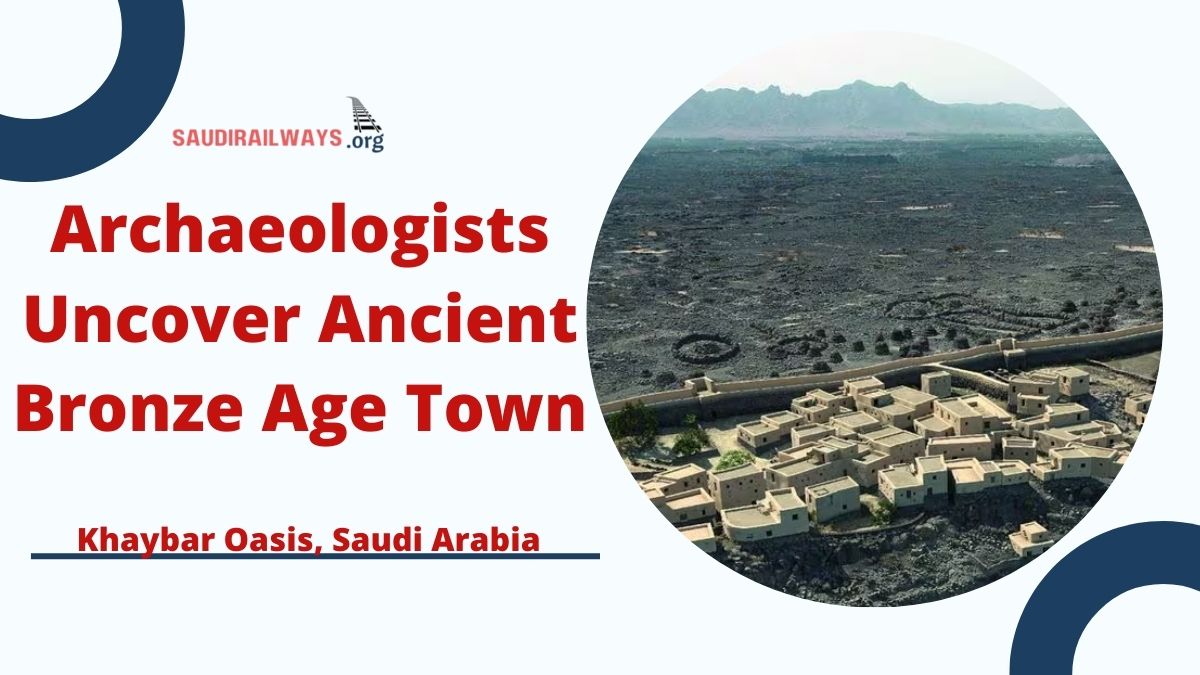In a groundbreaking archaeological discovery, researchers have uncovered a Bronze Age town nestled within Saudi Arabia’s Khaybar Oasis. Dating back approximately 4,000 years, this ancient town, known as Al-Natah, sheds light on early urban development, agriculture, and trade in the Arabian Peninsula.
Located in northwest Saudi Arabia, this discovery not only highlights the region’s rich history but also challenges previous assumptions about the predominance of nomadic lifestyles in early Arabian societies.
This article delves into the significance of the Khaybar Oasis discovery, its implications for understanding Bronze Age society, and the unique insights it offers into early urbanization in the region.
Contents
- Unearthing Al-Natah: A Fortified Town from the Bronze Age
- Archaeological Significance of Al-Natah: Shifting from Nomadic to Urban Lifestyles
- Trade and Economy in Al-Natah: Connections Across the Desert
- The Oasis as a Hub of Life: Agricultural Practices and Social Organization
- Archaeological Techniques and Discoveries
- Implications for Future Research on Early Arabian Societies
- Conclusion
- FAQs About the Bronze Age Town of Al-Natah
Unearthing Al-Natah: A Fortified Town from the Bronze Age
The Khaybar Oasis, located in northwest Saudi Arabia, is a lush, fertile area surrounded by the stark deserts of the Arabian Peninsula. Within this oasis, archaeologists recently uncovered Al-Natah, a Bronze Age settlement that dates back to around 2400–2000 BCE. This fortified town was inhabited by roughly 500 residents and showcases an early example of organized urban life in Arabia.
Al-Natah’s settlement patterns reveal a clear division between residential and funerary areas, offering valuable information on the social and cultural practices of its inhabitants. Surrounded by a 15-kilometer-long stone wall, the town’s defensive architecture hints at the challenges faced by its residents, from external threats to environmental pressures.
Discovery |
Details |
|---|---|
Location |
Khaybar Oasis, northwest Saudi Arabia |
Age |
Approximately 4,000 years (2400–2000 BCE) |
Inhabitants |
Estimated population of 500 |
Defensive Structure |
15-kilometer stone wall surrounding the town |
Archaeological Significance of Al-Natah: Shifting from Nomadic to Urban Lifestyles
The discovery of Al-Natah challenges long-standing views that early Arabian societies were predominantly nomadic. Traditionally, historians and archaeologists believed that the desert climate and scarcity of resources made a settled, urban lifestyle unsustainable in the region. However, the existence of Al-Natah suggests that small, fortified communities like this played an essential role in the gradual shift from nomadic herding to more organized urban life.
The architecture and layout of Al-Natah indicate that its residents were skilled in construction and agricultural practices. Findings at the site reveal evidence of multi-story buildings and complex pathways, hinting at a level of social organization and knowledge of construction techniques not typically associated with Bronze Age Arabian societies.
Aspect of Significance |
Explanation |
|---|---|
Urbanization Shift |
Evidence of transition from nomadic to urban |
Agricultural Knowledge |
Advanced farming techniques in arid conditions |
Architectural Complexity |
Multi-story buildings and complex pathways |
Historical Challenge |
Challenges the notion of Arabia as only nomadic |
Trade and Economy in Al-Natah: Connections Across the Desert
The discovery of Al-Natah also sheds light on the economic interactions between early Arabian societies and neighboring regions. Artifacts found at the site, including pottery fragments and metal objects, suggest that Al-Natah maintained trade connections with other Bronze Age communities. This trade likely involved not only goods but also ideas and technologies, contributing to the growth of early Arabian societies.
The presence of metal artifacts, such as tools and weapons, suggests that Al-Natah’s residents had access to metalworking knowledge and trade routes that linked them to other areas in the region. This indicates a sophisticated understanding of resource utilization, as well as a network of relationships that may have spanned beyond the Arabian Peninsula.
Economic Aspect |
Details |
|---|---|
Artifacts Discovered |
Pottery, metal tools, and weapons |
Trade Networks |
Connections with other Bronze Age communities |
Metalworking Knowledge |
Evidence of advanced resource utilization |
Cultural Exchange |
Likely exchanged goods, ideas, and technologies |
The Oasis as a Hub of Life: Agricultural Practices and Social Organization
Khaybar Oasis itself played a critical role in sustaining life at Al-Natah. The fertile land allowed for the development of agriculture, which was crucial to supporting a settled population. The residents of Al-Natah practiced farming in this arid environment, cultivating crops and possibly raising livestock within the protection of their fortified walls.
The town’s layout suggests a well-organized society with designated areas for housing, communal activities, and burial sites. This organization reflects a level of social cohesion and stability that enabled residents to thrive in the challenging desert environment. The combination of agriculture and fortified defense points to a community that was prepared to face both environmental and social challenges.
Aspect of Social Organization |
Details |
|---|---|
Agriculture |
Farming supported by the oasis’s fertility |
Social Structure |
Clear residential, communal, and burial zones |
Adaptation |
Defensive and agricultural strategies for survival |
Archaeological Techniques and Discoveries
Archaeologists used a range of methods to uncover Al-Natah’s secrets, including satellite imagery, excavation, and 3D mapping. These techniques allowed researchers to observe structural patterns, such as house foundations and walkways, before even setting foot on the site. Satellite images revealed the layout of the town and highlighted architectural features that hinted at the sophistication of the society.
One notable discovery was the presence of stepped tower tombs within the necropolis, or burial area, of Al-Natah. These tombs suggest unique funerary practices and offer insight into the spiritual beliefs of the time. The town’s intricate design and multi-story structures indicate advanced planning, with some archaeologists suggesting that the community had established architectural norms that reflected its social and cultural values.
Archaeological Techniques |
Purpose |
|---|---|
Satellite Imagery |
Observed town layout and structural patterns |
3D Mapping |
Created detailed models of architectural design |
Excavation |
Recovered artifacts and human remains |
Analysis of Tombs |
Gained insights into spiritual and cultural beliefs |
Implications for Future Research on Early Arabian Societies
The discovery of Al-Natah opens new doors for understanding the complexities of early Arabian societies. Researchers are now interested in exploring how similar towns might have existed across the Arabian Peninsula, challenging the belief that the region’s history was primarily shaped by nomadic cultures.
Al-Natah provides a model of “slow urbanism,” where small, organized communities gradually adapted to desert life, balancing traditional nomadic practices with emerging urban lifestyles. This approach to urbanization differs significantly from the rapid growth seen in early cities of Mesopotamia and Egypt, offering a unique glimpse into how environmental conditions influenced social development in Arabia.
Future research may focus on exploring other oases and fortified sites in the Arabian Peninsula to develop a broader understanding of early Arabian urbanization and its impact on trade and culture. The insights gained from Al-Natah underscore the resilience and adaptability of its inhabitants, offering lessons on how early societies managed to thrive in extreme environments.
Conclusion
The discovery of Al-Natah in the Khaybar Oasis marks a milestone in understanding the history of urbanization in the Arabian Peninsula. This ancient town serves as a testament to the adaptability and resilience of early Arabian societies, offering valuable insights into how communities managed to sustain life in challenging desert conditions.
Al-Natah’s history adds a new dimension to our knowledge of the Arabian Peninsula, highlighting the importance of trade, social organization, and agricultural innovation in shaping early societies. As archaeologists continue to explore sites like Al-Natah, they open a window into the past, illuminating the complex and dynamic world of Bronze Age Arabia.
FAQs About the Bronze Age Town of Al-Natah
What is Al-Natah, and where is it located?
Al-Natah is a Bronze Age fortified town discovered within the Khaybar Oasis in northwest Saudi Arabia. It dates back approximately 4,000 years and was inhabited by about 500 people.
Why is Al-Natah’s discovery significant?
The discovery challenges previous assumptions that early Arabian societies were primarily nomadic. Al-Natah provides evidence of organized urban life, agricultural practices, and trade, suggesting a more complex social structure.
What unique features were found at Al-Natah?
Key features include a 15-kilometer stone wall, stepped tower tombs, multi-story buildings, and artifacts like pottery and metal tools, indicating trade connections and advanced architectural techniques.

I am a passionate technology and business enthusiast, constantly exploring the intersection where innovation meets entrepreneurship. With a keen eye for emerging trends and a deep understanding of market dynamics, I provide insightful analysis and commentary on the latest advancements shaping the tech industry.
